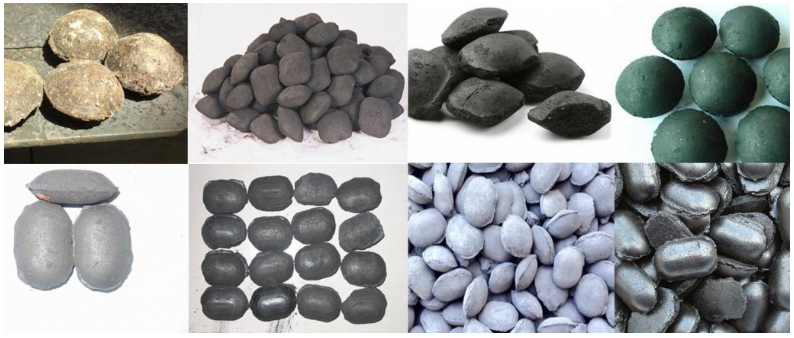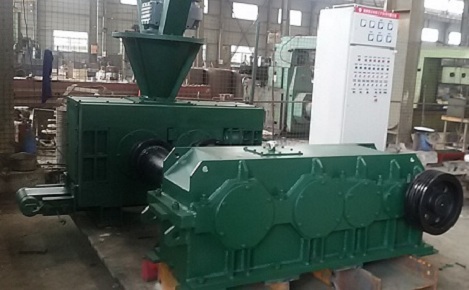Briquetting equipment
As a very mature modern process equipment, briquetting is widely used in many industrial fields. As a process to reduce the need for dust removal and ventilation, the finished products can also be sold as final products. High pressure briquetting is also called hydraulic ball press. So what is high pressure briquetting? Our definition is the normal linear specific pressure is (50-120) KN/CM, and the common ones are 80KN/CM, 110KN/CM, 120KN/CM and 150KN/CM. (line pressure: refers to the equipment pressure in the unit width in the direction of the roller width, which is an important indicator to measure the performance of the briquetting machine.) the high-pressure briquetting machine is suitable for the forming of boiler briquette, cold pressing coke, civil metallurgy, material resistance, medicine and other materials.
Applied materials:
• Minerals: bauxite, limestone, aluminum ash, dolomite, gypsum, clay, magnesium oxide, vanadium pentoxide...
• Metallic minerals: chromium nickel iron, manganese metal powder, silicon manganese alloy, molybdenum oxide, chromium ore powder, manganese ore powder, chromium iron, nickel iron...
• Cold pressing block of direct reduced iron
• All kinds of dust removal ash (electric furnace dust removal ash, converter dust removal ash, blast furnace dust removal ash, sintering powder, coke powder...)
• Coal, carbon black, graphite, charcoal...
• Iron coke, carbon pellets...

Briquetting principle:
The motor driven screw feeding device of the equipment places the material into the feeding port, and then the powder body material is sent to the two opposite rotating rollers. One of those is a movable roller and the other one is fixed. The pressure is provided frrom the hydraulic system, and the material is fed and compressed into shape between the rollers. There are customized molds on the surface of the press roller, and the geometric dimensions of the molds can be customized. The materials fed into the roller may be single material or mixed materials, or some binder may be added to improve the pelletization.
Main features:
The driving system consists: motor -- elastic coupling (belt drive) -- double output shaft reducer -- gear coupling -- two pressure rollers.
Assembly form of the press roller: three structures: hot-mounted structure, detachable expansion and tightening sleeve, and Mosaic structure of the segmented roller sleeve.
Roller material: high quality bearing steel, cold working die steel martensite stainless steel (suitable for acid materials).
Bearing assembly: with return sleeve structure, equipped with special tools for disassembly and assembly.
Prepressing screw: one of the core technologies. According to the material characteristic (mainly refers to the fluidity, the abrasiveness, the granularity) the special design, with the cleaning and the extrusion function. Variable pitch spiral is designed for some difficult molding materials.


P1. Preloading spiral (Kaizheng) P2. Grinding with roller press (Kaizheng)
Technical parameters:
| Model | Roller diameter (mm) | Roller width (mm) | Maximum pressure (t) | Line pressure (KN/cm) | Main power (kw) | Production capacity (m³/h) |
| KGY430-100 | 430 | 80-120 | 100 | 80-120 | 30-37 | Depends on material specific gravity and ball size |
| KGY520-150 | 520 | 120-200 | 150 | 80-120 | 55-75 | |
| KGY650-220 | 650 | 180-270 | 220 | 80-120 | 90-110 | |
| KGY750-300 | 750 | 250-350 | 300 | 80-120 | 185-220 | |
| KGY850-400 | 850 | 330-500 | 400 | 80-120 | 250 | |
| KGY1000-550 | 1000 | 360-650 | 550 | 80-150 | 315 | |
| KGY1200-800 | 1200 | 500-720 | 800 | 110-150 | 500 | |
| KGY1400-1200 | 1400 | 800-1000 | 1200 | 110-150 | 2×315 |
1. Our company has a pressure ball testing machine, can receive the user's material for experiment, to determine its pellet-forming performance and reasonable line pressure.
2. For high-pressure briquetting machine, common linear pressure ratios are: 80KN/cm, 110KN/cm, and 140KN/cm.




